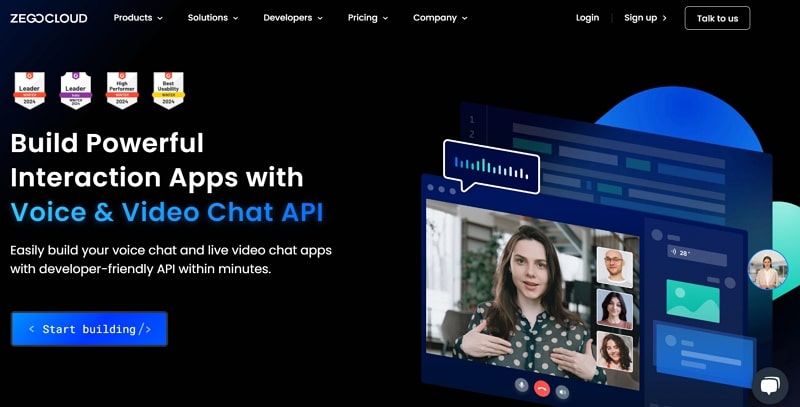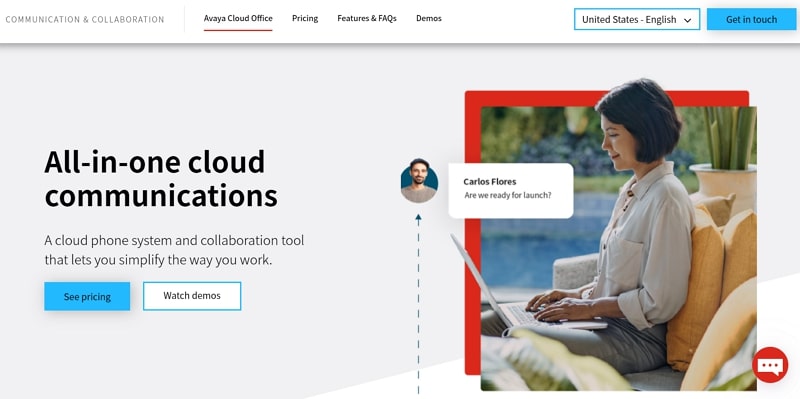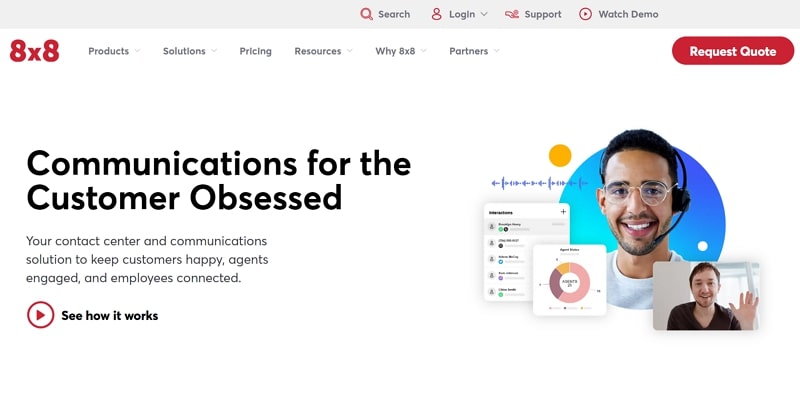Switching between the apps to check messages or participate in meetings will disrupt your workflow and reduce productivity. All these problems require unified communications solutions to let professionals interact with others within a single platform. Therefore, this article will discuss the concept of unified communications and introduce the top unified communications platforms.
What is Unified Communications?
Unified communications is a transformative technology framework that integrates various interaction tools into a unified system. In essence, it breaks down the barriers experienced when using different communication methods. Moreover, the unified communications system can provide a single point of access for all communication needs.
Using this communication system, users can access all functionalities, manage contacts, and switch between channels through a single interface. With its seamless interactivity, it also eliminates the need to constantly log in and out of different apps for communication. After understanding what is unified communications, let’s consider its various deployment models.
- Single-Tenancy: This model provides a dedicated UCaaS platform built specifically for your organization. Plus, it acts like a custom-built software platform, offering high levels of security, control, and customization. Therefore, it is best suited for large organizations with complex needs and substantial security requirements.
- Multi-Tenancy: It utilizes a shared unified communication platform hosted by the service provider. When talking about this model, multiple organizations share the same infrastructure. However, you have less control over the platform, facing limited customization options.
- Hybrid Model: Some providers offer a hybrid model that combines elements of both single tenancy and multi-tenancy. This proves to be a good option for organizations requiring customization but also wanting lower costs of unified communications.
If you want to employ different communication systems in your application, APIs are available for this purpose. For this purpose, ZEGOCLOUD provides you with in-app chat, video calls, and voice call APIs for developing a unified communications system.

Benefits of Implementing Unified Communications
Now, you have the basic knowledge of what is unified communications. It is time to talk about the different benefits these systems have to offer to professionals and organizations.
- UC solutions reduce the time spent switching between different tools by providing a centralized platform for collaboration.
- If you put various communication tools into a single platform, it will result in cost savings for your business.
- The unified communications system also facilitates seamless collaboration, leading to faster decision-making and better teamwork.
- Plus, these platforms can improve customer service by enabling faster response times.
- Businesses can quickly scale unified communication solutions to allow them to add or remove features as their needs evolve.
- With the rise of remote work, these solutions play a crucial role in enabling employees to collaborate effectively from anywhere, using any device.
How Does UC Systems Work?
As discussed, UC seamlessly integrates various communication methods into a single system. Let’s dive into the technical aspects of how unified communications technology works.
1. Integration and Interoperability
At the heart of UC lies a complex integration layer that connects diverse communication tools and platforms. So, this layer acts as a translator to ensure different systems can exchange data seamlessly. For this, it utilizes various interoperability standards like SIP and WebRTC.
2. Back-End Infrastructure
The integration layer of the unified communications platform is supported by a vital back-end infrastructure. It is comprised of servers and IP-PBX to enable the functionality of such interactions. Other than that, real-time communication servers and data storage are also there for seamless calls and video conferencing operations.
3. User Interface and Experience
Users interact with this system through a unified UI, making it accessible via desktop or mobile apps. So, this single interface provides access to all communication features, including making calls, sending messages, and managing contacts.
4. Network and Security
Unified communication providers heavily rely on a reliable network infrastructure to ensure communication flow. Therefore, security protocols are implemented to protect user data from unauthorized breaches.
The Key Components of These Unified Communications
A complete unified communication system allows several ways through which users can interact. The main components of this innovative technology are explained below:
- Voice Calling: It includes traditional phone calls, as well as features such as voicemail, call transfer, and call conferencing. So, UC integrates these various voice communication methods to provide seamless calling experiences.
- Messaging: Instant messaging and SMS allow real-time text-based communication between users. Plus, it lets users send and receive messages from different channels in a single conversation thread.
- Web Conferencing: Using this component, participants can hold virtual meetings, discussions, and presentations. Moreover, it comes with features such as screen sharing and document collaboration for better interaction.
- Email Integration: Email remains a primary form of communication in many organizations. Therefore, unified communication platforms integrate email functionality to allow users to access and send their emails.
- Collaboration Tools: These tools allow users to work together on documents, projects, and other tasks in real time. For this purpose, some significant tools include file sharing, whiteboarding, and task management.
Top 5 Unified Communications Platforms in 2024
After getting an in-depth understanding of UC technology, you may be curious about the best platforms related to these services. So, we will put forward the best unified communications platforms to help you make an informed choice.
1. ZEGOCLOUD

ZEGOCLOUD stands out as one of the top unified communication providers, with over 20 pre-built UIKits to create interactive applications. It allows users to integrate in-app chat features into their software for better communication. Moreover, this feature supports one-on-one conversations, group chats, and even public groups to allow teams to collaborate. Besides chatting, it provides voice-calling unified communication solutions to the users.
Additionally, ZEGOCLOUD lets its users integrate video conferencing features into their systems for unified communications. With this API, professionals will be able to streamline the workflow using screen sharing and co-hosting functionalities. All in all, this unified communications provider delivers all the features necessary for team collaboration under one umbrella.
2. GoTo Connect

With over 100 powerful features, this UC platform allows professionals to interact with each other without any interruption. Plus, this unified communications system has the functionality, such as screen sharing and personal meeting rooms, to help in remote work scenarios. Also, it boasts multi-channel support that allows you to interact with customers through SMS, chats, videos, and more.
3. Nextiva

Nextiva is an AI-integrated UC platform that supports various communication platforms for enhanced collaboration. With this platform, you can integrate voice, video, email, and other automation all in one place. Other than that, it offers cloud-based VoIP phone service with an advanced call analytic system. Plus, you can integrate this unified communications system with other apps like Zendesk and Microsoft Office.
4. Avaya

Using this unified communications provider, you can integrate VoIP with other features, including meeting room and HD video chat. It also provides its users with group chat functionality, which allows them to store and preserve shared documents. In addition, this UC platform automates your workflow to deliver a great customer experience.
5. 8×8

If you want a platform with top-quality call workflows, 8×8 can be your go-to UC provider. This platform even records and shares virtual meetings in cloud storage. Other than that, you can utilize its AI-powered virtual call agents to communicate with customers. Also, it effortlessly integrates with other CRM apps to take your productivity to the next level.
The Future Of Unified Communications
As technology continues to evolve, unified communications systems will also progress. Here are some of the future predictions about the innovations in UC technology:
1. Artificial Intelligence Integration
The role of AI in UC is expanding beyond basic features like meeting summaries and predictive text. We can expect AI to analyze real-time conversations to extract critical data for better decision-making. In addition to that, smart assistants will also be introduced to provide contextually relevant information during meetings.
2. Continued Growth of UCaaS
With the increasing implementation of remote work modes, the UCaaS market is projected to keep growing. Also, factors such as subscription-based models and scalability will play their role in its expansion.
3. Focus on Security and Interoperability
With the increase in cyber threats, security will be a critical focus for future unified communication solutions. These systems must implement robust encryption and authentication mechanisms to protect sensitive communications.
4. Integration with Emerging Technologies
Unified communications platforms are expected to integrate with the latest technologies. These systems will integrate with Internet of Things devices to enable seamless communication. Therefore, you can expect features such as voice control, real-time monitoring, and integration with IoT sensors. Furthermore, its integration with VR and AR will enable the creation of immersive meeting experiences.
Conclusion
Throughout this article, we have explained how unified communication systems change the way professionals interact. All the tools mentioned in this article will allow you to collaborate with your team for better workflow. However, if you want to know about the best tool, ZEGOCLOUD stands at the top. With its various communication APIs and SDKs, developers can integrate voice/video calling and chat features in their apps.

Read more:
Let’s Build APP Together
Start building with real-time video, voice & chat SDK for apps today!










